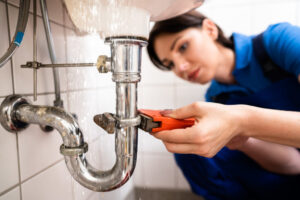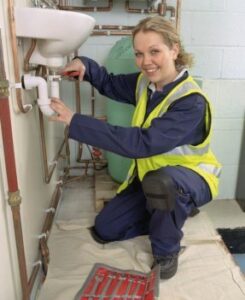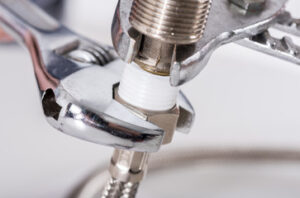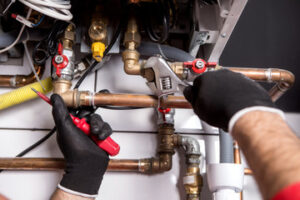Plumbing is essential for supplying water, removing waste, and heating and cooling buildings. It also protects buildings against damage caused by water.
Plumbers work in a variety of settings, from residential to commercial and industrial. They interpret blueprints and building codes to plan plumbing installations, and they install, inspect, and repair pipes, fixtures, and appliances. Contact Hubbard Mechanical now!

A septic system is an underground wastewater treatment structure used in areas that lack centralized sewer systems. A septic tank and a network of perforated pipes that slowly release wastewater to the soil are key components of a septic system. This type of onsite waste management system combines nature with tried-and-true technology to treat wastewater from bathrooms, kitchen drains, laundry and the like.
A typical septic tank is made of concrete, fiberglass or plastic and is usually rectangular in shape. It has a lid that is secured over an opening that’s located midway between the floor and the roof of the tank. One end is connected to an inlet wastewater pipe and the other to a septic drain field or leach lines.
Sediment and floatable waste, such as fats, oils and greases, sink to the bottom of the septic tank where it forms a layer known as sludge. Bacteria inside the septic tank digest these materials and release a clear fluid, called slurrified wastewater, or effluent. The septic tank also traps odor-causing gases, such as methane and carbon dioxide.
All of the wastewater in a septic system enters and exits the tank through a series of perforated pipes buried underground, sometimes along with other special devices that help to slow-release the wastewater to the soil. The wastewater is then absorbed into the ground through the pores in the soil, percolation or by uptake through the root systems of plants. Some alternative systems use pumps or gravity to help the septic tank effluent trickle through sand, organic matter (e.g., peat and sawdust), constructed wetlands or other media to further treat the water before it’s discharged into the soil.
An important point to remember is that septic tanks are only designed to hold specific amounts of wastewater. If a septic tank or the leach lines that filter the wastewater become overloaded, it can cause sewage to back up into the home through drains. Severe rain, prolonged wet weather or overcrowding at a septic tank or leach line can lead to overflow.
The best way to avoid a costly septic tank failure is regular inspection and maintenance by a qualified professional. It’s also recommended that homeowners add 8 to 12-inches of mulch around the septic tank, pipes and drain field to help prevent soil compaction.
Traditional tank water heaters boil and store hot water in a large insulated tank until it’s needed. They can be powered by electricity, natural gas or fuel oil. They come in different sizes so you can find the right one for your household’s peak water usage. This system is also one of the most affordable options.
Cold water enters the insulated tank through the house’s main cold-water supply line. As the cold water comes in, it hits a dip tube that guides the water to the bottom of the tank. A gas burner or heating elements then heats the water to a preset temperature. The hottest water settles at the top of the tank, because hot water has less density and rises by nature.
When you want to use hot water, the hot-water discharge pipe on the top of the tank releases it into the home’s plumbing system. This pipe can have a red handle to indicate it’s the water heater’s shutoff valve. There’s usually a drain valve located near the bottom of the tank to drain sediment from the tank when necessary. Many glass-lined tanks also have an aluminum or magnesium metal rod known as a sacrificial anode that’s fastened to the inside of the tank. This rod draws rust-causing ions from the water and protects the tank from corrosion.
In addition to the hot-water outlet and drain valves, tank-type water heaters usually have a control panel where you can check the status of the system and set operating modes. Some models have digital displays and easy-to-read controls. Others have an analog dial and push buttons to control the operation of the heater and select the desired temperature.
If your home has a tank-type water heater, you should install an expansion tank to keep the system from overheating. The expansion tank allows the water to expand and contract, which helps control high water pressures. Without an expansion tank, high water pressures can strain the system, taxing the glass lining of the water heater and causing damage to other parts of your plumbing system.
A distribution box (also called a d-box) is an important component of the plumbing system because it controls the even flow of wastewater from the septic tank to the drain field. This balance is critical for the effective operation of a septic system and helps to prevent problems such as backups and even complete septic system failure.
A septic distribution box is typically located between the septic tank and the leach field. From here, a series of perforated pipes lead to individual sections of the drain field. The septic system is then filled in these areas with a mixture of clay and sand. This is then covered with a layer of top soil in which grass grows.
The distribution box serves as the traffic cop for the septic system. It controls the amount of wastewater that is directed to each section of the drain field. If too much is sent to one area, the effluent might not be adequately treated. Conversely, if too little effluent is discharged to an area, that part of the drain field might be overloaded, leading to clogs and other serious issues.
This is why it’s so important to ensure that the septic tank and the distribution box are properly installed and regularly maintained. This means regular pumping and inspections to keep the septic tank and distribution box functioning properly.
Problems with the septic distribution box might include:
- Foul odors.
- Flooding in the drain field or other parts of the home.
- Unequal distribution of wastewater in the drain field.
A septic system professional can help diagnose and repair any issues with the distribution box and the septic system in general.
A septic distribution box is usually found within about 20 feet of the septic tank, and it’s usually only about one foot below the surface of the ground. Unlike the septic tank, which can be hard to find in some cases, it’s usually fairly easy to locate the box by probing the soil carefully with a long probe rod. Whether it’s made of concrete or plastic, a distribution box is a rectangular container with a number of openings that septic pipes fit into. The openings are usually surrounded by a septic tank lid for protection.
Pump stations are the heart of water supply and wastewater systems. Working tirelessly behind the scenes, they maintain hydraulic balance in urban pipelines, provide a steady flow of clean water to homes, businesses and industry, and direct sewage away from residential areas. They’re also an essential part of flood control, preventing environmental contamination and keeping communities safe.
Pumping stations come in two different forms, above and below ground. Above ground pumping stations are perfect for sites where a below-ground station isn’t an option, whether due to restricted below-ground space or limitations on construction in historic/protected locations. They’re designed to pump waste water, sewage and surface water from areas that cannot be drained by gravity to a common drain, manhole or sewer.
Below ground pumping stations are a discrete solution for controlling wastewater, drainage water and sewage in housing estates, schools, hospitals, nursing homes, hotels, industrial complexes and many other operations. They’re a popular waste management solution choice because they eliminate the need for expensive underground pipes and are easy to install, operate and maintain.
The type of pump station you choose will depend on the volume of liquid that needs to be pumped. If the liquid has a high water content, a higher-powered system will be required. For low-volume liquids like effluent and domestic wastewater, a lower-powered pump may be sufficient. In either case, the pumps are activated by a float switch that monitors the liquid level. When the switch reaches a preset water level, it activates the pump.
Regulatory agencies require that pumping stations be “duplex,” with standby (redundant) pumps capable of handling peak hourly flows. This reduces the risk of a failure of one or more of the pumps and provides for uninterrupted service. The capacity of a pump station is often determined by its average daily flow (ADF).
Pump stations need to be able to handle the maximum expected flow rate for a long period of time. This is accomplished by designing the station to be able to expand in capacity as demand increases, which can usually be done without increasing the footprint of the station.






